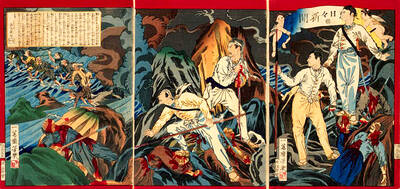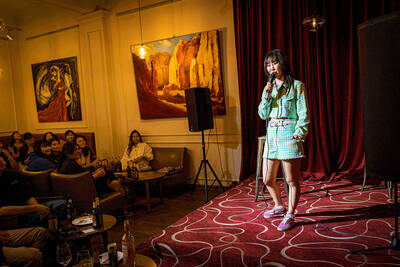The children come day after day, lining up in the cold and snow on Main Street in Midland, Michigan to wait their turn to enter Santa’s house and whisper their Christmas longings to the jolly man in the red suit.
“Cellphone.”
“IPad.”

Photo: Reuters
“Notebook.”
And when they say such things, Tom Valent, now in his 38th year as Santa Claus, unleashes his best “Ho-ho-ho” and replies: “Well, I’m good at toys. Electronics — that’s a bit of a challenge.”
Sure, children still want and receive trains and dolls and Legos and other playthings of the type that Santa might make in his North Pole workshop.

Photo: Reuters
But their passion for playing with toys seems to be diminishing at earlier and earlier ages. After all, this is a generation that learned to amuse itself practically from babyhood with the smartphone and tablet swiped from their parents’ hands.
For Hanukkah this year, Maddon Segall asked for iTunes gift cards and the new iPad mini. He is 3.
“I hate to tell you, but we got it for him,” said his mother, Elyse Bender-Segall, of Livingston, New Jersey. She added: “He doesn’t like the toys. I buy him every toy. He’s just not interested in them the way he is with the tech.”
A recent survey of 1,000 parents with children between 2 and 10 found that more than half planned to buy a tech item for their children this holiday season. About two-thirds of those planned to give a tablet or smartphone, according to the survey, which was taken for PBS Kids, the brand of the public broadcasting network aimed at young children.
“Smarter Giving With Apps!” shouted the December cover of Manhattan Family, a monthly publication geared to families with young children. The article, written by a kindergarten teacher, noted that “traditional gifts, like clothes and toys” can be costly “and not always what children are wishing for.” Apps, on the other hand, she wrote, are cost-effective, educational and fun — the perfect gift.
It is a confounding situation for toymakers, which, according to the Toy Industry Association and statistics compiled by NPD Group, have barely managed to eke out any gains in the past few years. Contributing to the doldrums is the fact that there is no super-hot, must-have toy this holiday season — no 2013 equivalent of the Cabbage Patch doll or the Tickle Me Elmo or even the Zhu Zhu Pet.
Instead, some in the industry are trying to get a piece of the tech action. While electronic games have long been a staple of toy stores, this year, for the first time, Toys “R” Us introduced hands-on tablet displays in many of its stores, including iPads and Samsung tablets. The company has also designed and developed its own tablet for young children, the Tabeo e2, which, a spokeswoman said, “comes right out the box with 30 premium apps.”
On a recent snowy morning, the first thing holiday shoppers saw after entering the Toys “R” Us flagship store in Times Square (after being welcomed by a man in a giraffe costume) was a sign advertising the iPad.
“Increasingly tablets are a key growth category for the company,” said Adrienne O’Hara, the company’s director of consumer public relations.
GOING ‘RETRO’
But as the holiday shopping season is wrapping up, some parents have resisted.
The Easy Bake Oven, which celebrated its 50th birthday this year, has been a strong seller at Wal-Mart in recent weeks. Hot Wheels are having a good season, industry experts say, as are the Barbie Dream House and Teenage Mutant Ninja Turtles. Even Mr. Potato Head is still around.
“In many ways, retro is being fueled by the virtualization of toys,” said Eric Johnson, dean of the Owen Graduate School of Management at Vanderbilt University, who has studied the toy industry.
“I think there’s a mindset in a lot of young moms that a physical toy is a good thing, it’s almost a backlash to the popularity of the app,” he said. “So they head down the toy aisle, and they find something they remember.”
Indeed, nostalgia can be a powerful tool for retailers. Part of that is brand recognition, because just like finding a familiar box of Cheerios in the grocery store, Barbie and G.I. Joe need no introduction. But there is also something more emotional at play.
“When you look at things like Cabbage Patch, to Hot Wheels, to Elmo, parents see these things they had and they loved,” said Jim Silver, editor in chief of TimetoPlayMag.com. “If it was one of their favorites, they want to share that experience with their child.”
A parent’s experience as an adult is also relevant. Plenty of people love a good game of Angry Birds, but less pleasant associations also attach to tablets and phones, like late night e-mails from the boss.
“I think for parents, these kind of adult toys symbolize work and other things that don’t necessarily symbolize childhood,” Johnson said of apps and tablets. “But Mr. Potato Head is childhood and carefree.”

In the March 9 edition of the Taipei Times a piece by Ninon Godefroy ran with the headine “The quiet, gentle rhythm of Taiwan.” It started with the line “Taiwan is a small, humble place. There is no Eiffel Tower, no pyramids — no singular attraction that draws the world’s attention.” I laughed out loud at that. This was out of no disrespect for the author or the piece, which made some interesting analogies and good points about how both Din Tai Fung’s and Taiwan Semiconductor Manufacturing Co’s (TSMC, 台積電) meticulous attention to detail and quality are not quite up to

April 21 to April 27 Hsieh Er’s (謝娥) political fortunes were rising fast after she got out of jail and joined the Chinese Nationalist Party (KMT) in December 1945. Not only did she hold key positions in various committees, she was elected the only woman on the Taipei City Council and headed to Nanjing in 1946 as the sole Taiwanese female representative to the National Constituent Assembly. With the support of first lady Soong May-ling (宋美齡), she started the Taipei Women’s Association and Taiwan Provincial Women’s Association, where she

It is one of the more remarkable facts of Taiwan history that it was never occupied or claimed by any of the numerous kingdoms of southern China — Han or otherwise — that lay just across the water from it. None of their brilliant ministers ever discovered that Taiwan was a “core interest” of the state whose annexation was “inevitable.” As Paul Kua notes in an excellent monograph laying out how the Portuguese gave Taiwan the name “Formosa,” the first Europeans to express an interest in occupying Taiwan were the Spanish. Tonio Andrade in his seminal work, How Taiwan Became Chinese,

Mongolian influencer Anudari Daarya looks effortlessly glamorous and carefree in her social media posts — but the classically trained pianist’s road to acceptance as a transgender artist has been anything but easy. She is one of a growing number of Mongolian LGBTQ youth challenging stereotypes and fighting for acceptance through media representation in the socially conservative country. LGBTQ Mongolians often hide their identities from their employers and colleagues for fear of discrimination, with a survey by the non-profit LGBT Centre Mongolia showing that only 20 percent of people felt comfortable coming out at work. Daarya, 25, said she has faced discrimination since she